PACKAGE: The Everything Package – Minnesota #1 (125 Clock Hours)
| Average Ratings | |
|---|---|
| Five Stars | |
![]()
![]()
![]()
![]()
![]()
“Your courses fit my needs perfectly.
They were ideal for someone who does not
have a great deal of flexibility, and I learned a lot.”
You’ve heard of the everything bagel, Professional Learning Board presents the first everything PD course package, The Everything Self-Study Package – Minnesota #1, which includes the following TWENTY-FIVE 5-hour self-study courses and saves you 25% over enrolling in them individually. Scroll down to see more information on the courses in this package.
|
Relicensure (125 hours)
|
# Hours
|
|---|---|
|
Accommodating All Learners
|
5
|
|
Bulletin Boards – Ideas for Every Classroom
|
5
|
|
Classroom Management for Positive Behaviors
|
5
|
|
Cognitive Skills – Understanding Learning Challenges
|
5
|
|
Cultural Competency and Responsive Teaching
|
5
|
|
Differentiation for Gifted Learners in the Classroom
|
5
|
|
English Language Learners in the Classroom
|
5
|
|
Ethics for Education Professionals
|
5
|
|
Formative Assessment
|
5
|
|
Internet Safety in a Connected World
|
5
|
|
Introduction to Autism
|
5
|
|
Introduction to Technology for Teachers
|
5
|
|
iPads in the Classroom
|
5
|
|
Partnering with Parents
|
5
|
|
Public Speaking for Teachers
|
5
|
|
Reading Across the Curriculum
|
5
|
|
RECOGNIZE Mental Health and Suicide Warning Signs
|
5
|
|
Recognizing & Preventing Child Abuse
|
5
|
|
Reflective Teaching Practices
|
5
|
|
Standards Based Instruction through STEM
Student-centered Learning |
5
5 |
|
Student Portfolios
Tackling Tough Text
|
5
5
|
|
Technology in the 21st Century Classroom
|
5
|
|
Understanding ADHD
|
5
|
|
TOTAL
|
125
|
Accommodating All Learners
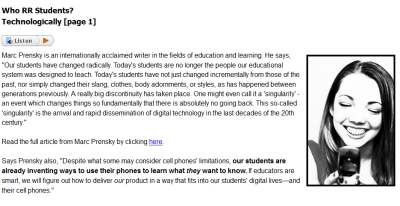 Reach and teach all learners by examining 21st century student and educator strengths in this research-based course packed with strategies, resources and tools. Participants will gain insight into both, their own learning and teaching preferences as well as the learning styles of students. Closely aligned with national standards and pedagogical goals.
Reach and teach all learners by examining 21st century student and educator strengths in this research-based course packed with strategies, resources and tools. Participants will gain insight into both, their own learning and teaching preferences as well as the learning styles of students. Closely aligned with national standards and pedagogical goals.
- Every Learner Learning
- Who’s Who: Teaching & Learning
- Who RR Students?
- Teaching Across Type
- Technology
- Theories & Strategies
Bulletin Boards – Ideas for Every Classroom
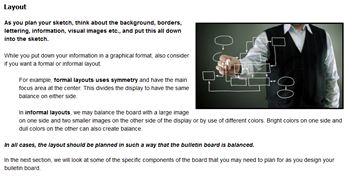 A classroom can seem incomplete without attractive and educative bulletin boards. Have you ever looked at another teacher’s bulletin boards and wondered how they managed to make it so interesting? Maybe you don’t have a lot of experience with art, or maybe you’re running low on creative ideas.
A classroom can seem incomplete without attractive and educative bulletin boards. Have you ever looked at another teacher’s bulletin boards and wondered how they managed to make it so interesting? Maybe you don’t have a lot of experience with art, or maybe you’re running low on creative ideas.
This course provides a new and fresh direction that helps teachers understand the basic principles of art and design and how to apply these in planning and creating bulletin boards. Included are a number of ideas for interesting, interactive and educative bulletin boards. Through this course, teachers come up with some very creative and visually effective ideas for their classrooms and often are inspired to create their own classroom bulletin board makeovers.
Cognitive Skills – Understanding Learning Challenges
The U.S. Department of Education, and others indicate that weak cognitive skills are the source of over 80% of learning problems.
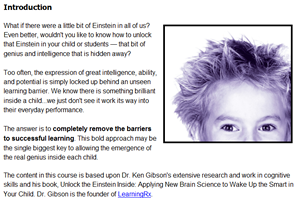 In this course you’ll come to understand the answer: students approach each task with varying learning tools. These tools are called cognitive skills, and these skills determine the quality, speed, and ease with which individuals learn and perform.
In this course you’ll come to understand the answer: students approach each task with varying learning tools. These tools are called cognitive skills, and these skills determine the quality, speed, and ease with which individuals learn and perform.
This course provides methods for detecting students with weak cognitive skills and tools to strengthen those skills. Teachers will receive understanding, as well as ways to apply development techniques in the classroom. The online class is fun and interactive and includes information about new brain research and how it can impact today’s classrooms.
Cultural Competency and Responsive Teaching
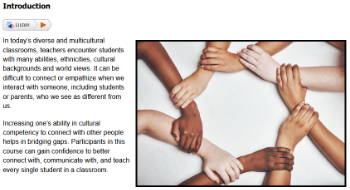 Teachers deepen their understanding of their own frames of reference, potential bias, and impact on expectations for and relationships with students, students’ families and school communities.
Teachers deepen their understanding of their own frames of reference, potential bias, and impact on expectations for and relationships with students, students’ families and school communities.
This course demonstrates responsive teaching in the classroom by helping teachers consider, connect with, and build competence in meeting the many learning needs of all students while addressing culturally diverse classrooms that are sensitive and equitable to learners across languages, genders, religions, cultural backgrounds, and special needs. Designed to meet state requirements for cultural competency and responsiveness training.
Differentiation for Gifted Learners in the Classroom
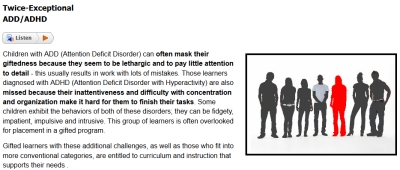 This course examines some of the challenges facing gifted learners and offers easily implemented accommodations and success strategies. By understanding the unique learning needs of children who are considered “gifted,” participants will indirectly meet the individual needs of all learners.
This course examines some of the challenges facing gifted learners and offers easily implemented accommodations and success strategies. By understanding the unique learning needs of children who are considered “gifted,” participants will indirectly meet the individual needs of all learners.
Through this course educators and parents can make greater sense of gifted and talented education by learning about identification, instruction and assessment of these students while exploring related topics, issues and resources geared towards our gifted population.
- Characteristics
- Personal, Social and Cognitive Needs
- Special Populations
- Practical Strategies
Ethics for Education Professionals
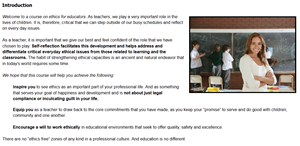 With the advent of the internet and smart phones, it’s easy for boundaries to become blurred. In the past it was rare for a student to call a teacher at home. Today, students and teachers are faced with numerous ways to contact one another 24/7. Things that in the past may have been black and white are now grey. Where do we draw the lines?
With the advent of the internet and smart phones, it’s easy for boundaries to become blurred. In the past it was rare for a student to call a teacher at home. Today, students and teachers are faced with numerous ways to contact one another 24/7. Things that in the past may have been black and white are now grey. Where do we draw the lines?
Even though most people believe that their actions are guided by logic and reason, we all have an innate ethical sense that urges us to make predictable choices. We each find words to create rationales that support our choices or decisions. However, ethics education is about recognizing the real power of our own innate ethical sense and how it influences our behaviors.
We build our ethical sense on beliefs that we already bring with us. This is why ethics is about individual’s personal choices. When we recognize and intuitively understand that ethics must be measured on a case-by-case basis, this type of ethical relationship can become a powerfully positive starting point for both educators and students. We must commit to broadening our understanding of ethical issues while at the same time seek to better understand the ideas of others.
Step inside this course and discover through reflection and introspection, an understanding of one’s innate ethical self. You’ll find tools and tips for bringing high standards of ethics into our schools and a variety of topics to explore practical ways to address ethical decisions in our lives at every stage.
Formative Assessment
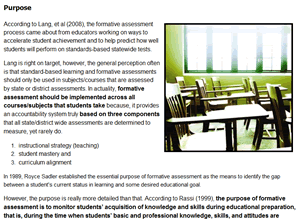 Is your school moving in the right direction?
Is your school moving in the right direction?
Can you tell if students are learning – how can you tell?
Brian Creasman became principal of a “low performing” high school and was confronted with these two questions. A high school classified as “low performing” obviously is not a title any teacher, administrator, student or parent wants for their school.
Out of everything (curriculum alignment, effective instructional strategies, etc.) Mr. Creasman learned that for an assessment to be effective, it should also be formative. Keep in mind that effective formative assessments result in instruction that meets the needs of each student. Formative assessments allow teachers to respond to the needs of the student quickly, however more importantly it allows the student to shape instruction (both a student-centered and teacher-driven education model).
The formative assessment program there continues and is constantly changing for the better. Once you have a well planned formative assessment program in place, your school will also see:
1) A change in the culture within classrooms
2) Concise communication of learning goals
3) Varied effective instructional methods
4) A new understanding for student learning
5) Improved student engagement with targeted student feedback
6) An increase in student learning!
Take the next step. Learn about and implement formative assessments in your school to discover and demonstrate for yourself, your students and your community what happens when a school moves in this direction and you know students are truly learning.
Internet Safety: Protecting Children in an Online World
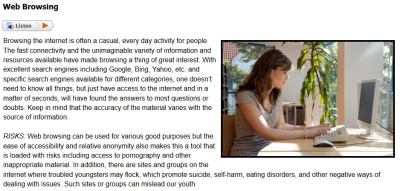 Issues that the youth of today, parents, teachers and those who are part of their world face online is the essence of this content. Participants discover areas of the Internet used by youth, what kinds of threats exist on the Internet and how everyone can protect their loved ones, family members, students and those under their care or responsibility. A special focus of the course includes ways in which adults can protect themselves online.
Issues that the youth of today, parents, teachers and those who are part of their world face online is the essence of this content. Participants discover areas of the Internet used by youth, what kinds of threats exist on the Internet and how everyone can protect their loved ones, family members, students and those under their care or responsibility. A special focus of the course includes ways in which adults can protect themselves online.
- Social networks
- Instant messaging & texting
- Chat rooms
- Gaming & virtual worlds
- Vulnerabilities of Children Online
- Cyberbullying
- Online predators
- Tips & tools for protecting children online
- And more…
Introduction to Autism
Most people today know someone with autism. People on the autism spectrum are in our classes, our neighborhoods and our families. Whether you know a little or a lot about autism, this course will give you useful information about the autism spectrum.
 Although everyone on the autism spectrum is an individual, this course outlines a constellation of developmental differences common in autism that lead to the key concerns of social and communication issues.
Although everyone on the autism spectrum is an individual, this course outlines a constellation of developmental differences common in autism that lead to the key concerns of social and communication issues.
A person with autism experiences the world in a different way. They think and remember events differently. They react and communicate differently. By understanding the how and why of these differences, you can become one who gains insight.
Understanding some of the different issues people with autism must face can help us to be more understanding and improve our interactions. By understanding how students with autism function, we can make more informed choices in education and care and, maybe most importantly, we can assess our own automatic hard-wired responses that might occur when someone is truly different.
By understanding the underlying components of developmental differences in those on the spectrum, teachers, parents and others can reframe their own preconceived expectations and help support the learning and behavior for those with autism. Learn to more clearly understand the world from the perspective of someone with autism.
Introduction to Technology for Teachers
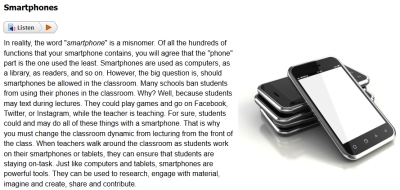 This interactive course introduces teachers to technology tools with one goal in mind: increasing teacher comfort level in using the Internet and today’s technology tools for teaching and learning. Teachers will learn new ways of using tools they are familiar with and be exposed to brand-new tools and applications for use both in professional development and with students in the classroom. Topics covered in this course:
This interactive course introduces teachers to technology tools with one goal in mind: increasing teacher comfort level in using the Internet and today’s technology tools for teaching and learning. Teachers will learn new ways of using tools they are familiar with and be exposed to brand-new tools and applications for use both in professional development and with students in the classroom. Topics covered in this course:
- Basic computer terminology
- Office applications
- Web tools
- Integrating technology in classroom lessons
- Using technology to enhance professional development
Partnering with Parents
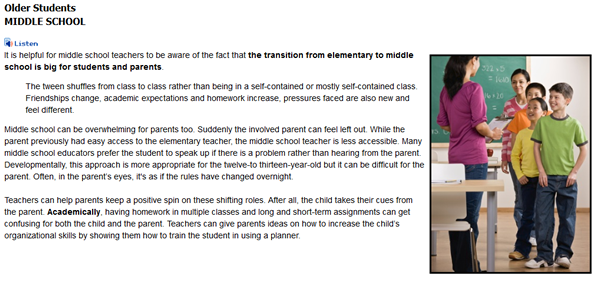 Many parents need motivation and support to help them partner with the teacher. In our profession as teachers, we must partner with the parents of our students. The “dream parents” are cooperative, freely volunteer and carry on the learning process at home. However, many parents need motivation and support to help them partner with the teacher.
Many parents need motivation and support to help them partner with the teacher. In our profession as teachers, we must partner with the parents of our students. The “dream parents” are cooperative, freely volunteer and carry on the learning process at home. However, many parents need motivation and support to help them partner with the teacher.
In this course, you will learn about various personalities and come away with an understanding of why parents think the way that they do. You will also discover strategies that you can use in a number of common challenging situations teachers face while working with parents. Finally, learn more about planning and organizing activities in your school.
This course will help you enhance your professional interaction and communication skills as well as help you build lasting relationships with the parents of your students
Positive Behavior Intervention Strategies
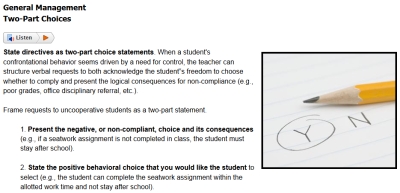 This course is based upon the extensive research, work and writings of Jim Wright, a Behavior Intervention Specialist, Psychologist and School Administrator in central New York. Mr. Wright has experience in the areas of Academic and Behavioral Interventions, Curriculum-based Measurement and Violence Prevention. This course will address research and strategies in the following areas:
This course is based upon the extensive research, work and writings of Jim Wright, a Behavior Intervention Specialist, Psychologist and School Administrator in central New York. Mr. Wright has experience in the areas of Academic and Behavioral Interventions, Curriculum-based Measurement and Violence Prevention. This course will address research and strategies in the following areas:
- Behavior Basics
- Group & Classroom Management
- Defiance & Non-compliance
- Impulsivity & Hyperactivity
- Attention & Motivation
Reading Across the Curriculum
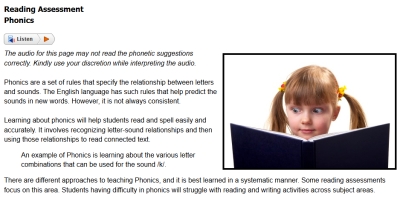 This interactive course is one option for K-12 teachers across the curriculum spectrum to demonstrate evidence of reading instruction techniques. Based on research, Reading Across the Curriculum introduces all teachers to sound reading instructional practices.
This interactive course is one option for K-12 teachers across the curriculum spectrum to demonstrate evidence of reading instruction techniques. Based on research, Reading Across the Curriculum introduces all teachers to sound reading instructional practices.
- Research
- Reading Range
- Meaningful Reading
- Strategies for Reaching All Students
- Includes Resources
- Reinforcement Activities
Recognizing & Preventing Child Abuse
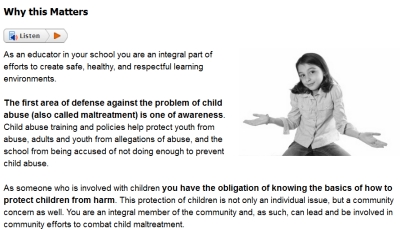 This course empowers each of us with the ability to recognize types, signs, characteristics, scenarios, and in general, indicators of suspected child abuse. We know this is a difficult subject to discuss. For that reason, we think you will find this course to be respectful of the topic while giving a solid foundation in understanding the key information about child abuse.
This course empowers each of us with the ability to recognize types, signs, characteristics, scenarios, and in general, indicators of suspected child abuse. We know this is a difficult subject to discuss. For that reason, we think you will find this course to be respectful of the topic while giving a solid foundation in understanding the key information about child abuse.
- What is Child Abuse
- Physical Abuse
- Sexual Abuse
- Neglect
- Emotional Abuse
- Safe Environment Practices
- Reporting & Resources
Recognizing Early-onset Mental Health Disorders in Children and Adolescents
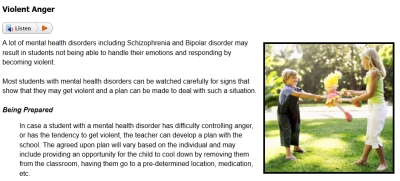 As educators and parents we are often, by default, among the first people to notice that a child may be experiencing problems. Completion of this course results in a basic understanding of warning signs of early-onset mental illness in children and adolescents which is useful to professional teaching and learning as it strengthens teacher-parent communications. Topics covered in this course:
As educators and parents we are often, by default, among the first people to notice that a child may be experiencing problems. Completion of this course results in a basic understanding of warning signs of early-onset mental illness in children and adolescents which is useful to professional teaching and learning as it strengthens teacher-parent communications. Topics covered in this course:
- What is mental illness
- Parent stages
- Communications
- What teachers can do
- Attention Deficit Hyperactive Disorder
- Oppositional Defiant Disorder
- Conduct Disorder
- Depression
- Bipolar Disorder
- Anxiety
- Schizophrenia
Have you wondered if your efforts and hard work are paying off? Have you spent time pondering over whether your teaching strategies are appropriate for your class and reviewing the results?
Developing a process of reflective thinking or reflective practice is a viable solution to this problem. Reflective practice is considered to be central to effective teacher preparation programs and the development of professional competence. A truly reflective teacher becomes sensitive and responsive to the needs, issues, and concerns that are so important in shaping qualitative educational practice. This course helps educators learn about various reflection and professional development practices that will enable you to become a reflective teacher and grow as an educational professional.
Standards Based Instruction through STEM

STEM integration doesn’t need a huge budget, lots of technology, or a ready-to-use curriculum. It’s something any teacher, any school and any classroom can integrate. This course teachers you how.
We understand that no one knows your students better than you. Therefore, this course is designed to equip and encourage you to integrate STEM education into your classrooms in ways that you think are most suitable for your students. You will learn how to plan your classroom set-up keeping in mind the needs of your students. You will also become confident to design your own STEM curriculum, while integrating the standards, including the Common Core Standards.
STEM education is not just about doing what’s “cool” and “in.” It is essential in today’s world that our students learn to apply what they learn in real life situations and across different subjects. The STEM model helps prepare our students for the 21st century.
Student-centered Learning
Have you been longing to see a group of students who are self-motivated, engaged in their learning and able to make real-world connections?
Teachers committed to real development in their students look forward to lively, stimulating and effective learning environments where their students are self-motivated, able to build on what they already know and equipped for the real-world. The Student-centered Learning approach provides a fitting framework for building such an environment that shifts focus from the basic implementation of standardized curriculum and assignments, to a more creative, organic facilitation of subject content and student activity.
This course presents resources, research-validated strategies and practical examples to equip teachers with the necessary toolkit to seamlessly turn their classrooms into student-centered environments. Some questions answered in this course include – Why is there a need for teachers and schools to change their approach to education? How does the Student-Centered Learning approach compliment achieving the common core standards? What is the teacher’s role in this new learning environment?
This course also details principles of Student-centered Learning, a comparison of teacher-led classrooms and student-centered classrooms, developing student-centered objectives, facets of understanding, practical teaching methods that can be used, and several online tools that will help achieve success.
Student Portfolios
Successfully integrate portfolios to enhance students’ development and become an essential part of teaching and learning. Through the resources in this course, teachers are equipped to understand and use portfolios to emphasize the student’s role of taking responsibility for their learning and the teacher’s role of guiding that learning. The practical tips and suggestions provided in this course will take teachers through the process of implementing portfolios in their classrooms, with factual information clearly linking student learning to the actual goal.
Teachers will be introduced to the concept of using portfolios as assessment tools, and the advantages of their implementation to both teachers and students. The resources included show teachers how to capitalize on the students natural tendency to save work, get them to take a second look and critically analyze how they can improve future work.
Questions answered in this course include – How do teachers take on the role of ‘portfolio advisors’, and guide students through the process of creating and maintain portfolios? What is the relevance of a portfolio? What are the objectives of an effective portfolio? Rich in examples, considerations, suggestions and tips for teachers, this course aims to enhance the teaching and learning experience for students.
Teaching English Language Learners
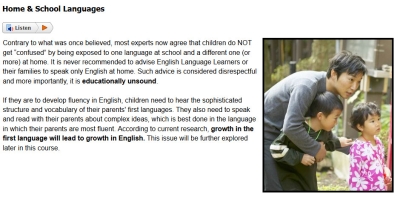 Any K-12 teacher, administrator, or support staff member who would like to help English Language Learners do well in school will find this course to be both informative and useful. The focus includes how to make ELLs and their families feel more welcome while generating academic successes through empowerment.
Any K-12 teacher, administrator, or support staff member who would like to help English Language Learners do well in school will find this course to be both informative and useful. The focus includes how to make ELLs and their families feel more welcome while generating academic successes through empowerment.
Participants will improve cross-cultural skills and examine cultural influences on school practices, and come away with greater insight into how second languages are acquired. They will also discover teaching methods and educational strategies for today’s diverse mainstream classroom that are considered best practice for reaching and teaching all learners. Included are highlighted practical tips and activities that can be put to use right away.
Technology in the 21st Century Classroom
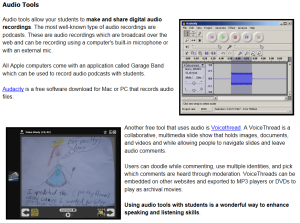 Technology has become an integral part of our life and learning patterns in the 21st century. The internet, blogs and smart phones are some examples of tools that we use to grow in our knowledge and understanding. Using technology like this in the classroom requires more than knowing how to use the tool. Teachers need to understand the role of technology in the learning process, and the principles behind integrating it in a way that it promotes learning without it being a distraction.
Technology has become an integral part of our life and learning patterns in the 21st century. The internet, blogs and smart phones are some examples of tools that we use to grow in our knowledge and understanding. Using technology like this in the classroom requires more than knowing how to use the tool. Teachers need to understand the role of technology in the learning process, and the principles behind integrating it in a way that it promotes learning without it being a distraction.
This course teaches concepts and ideas behind using technology in the classroom. It also helps teachers to understand the various skills that students need to develop in order to use technology in the most effective way. It equips teachers to help students use technology intelligently and responsibly.
Understanding ADHD
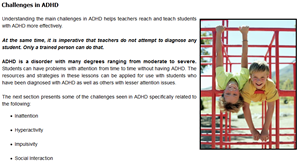 Have you ever come across a child who’s always on the move? They might have had ADHD. Attention Deficit Hyperactivity disorder or ADHD is seen commonly in today’s classroom. Children with this condition are restless, find it difficult to sit, are very impulsive and have a very short attention span. On the other hand they are also very intelligent and creative.
Have you ever come across a child who’s always on the move? They might have had ADHD. Attention Deficit Hyperactivity disorder or ADHD is seen commonly in today’s classroom. Children with this condition are restless, find it difficult to sit, are very impulsive and have a very short attention span. On the other hand they are also very intelligent and creative.
These energetic students can often disrupt a classroom. Thus, it becomes even more important for teachers to understand what this condition is all about and learn strategies to teach a child with ADHD.
This course does just that for you. It provides a variety of tips, adaptations and strategies that you can use while working in the classroom. You will learn about classroom modifications and adaptations that will help maintain order in the classroom. You will also discover methods for communicating more clearly with special educators and parents about their children. This course helps teachers gain confidence in not only handling ADHD, but also other students who are energetic, hyperactive or have difficulty paying attention.


I very much appreciate the opportunity to earn recertification points through this online program. I've learned a lot, and the courses were expertly written. I also enjoyed the option to ""listen to the text"" being read. It means more sensory needs for learners.
Taking online courses to fulfill necessary licensure requirements is a very useful and convenient way to help renew a teaching license! I like that this program is easy to use and fulfills the new requirements for my state license.
Thank you so much for offering these classes online! I have taken many of them and have enjoyed the learning experiences, and the live help that I received, too. I have encouraged other teacher at my school to try some of these classes for recertification. It's so much easier to have online classes that will fit into your schedule after work or during the summers.
Thank you for having this resource available to help meet licensure needs in a way that can fit into my schedule and finances!
This platform was so convenient and provided great new knowledge! As a stay at home mom who is seeking to keep my license current, the ease of use was invaluable. Thank you
WOW is all I can say...it was an accident that I found your site and what you had to offer. So far EVERYTHING with PLB has been top notch! I learned something, the experience has been exceptional, and now the paperwork to get the transcript from the university for my re-licensee and lane change seems to easy...I'm starting my next class today. I plan on letting my colleagues all know about you for their future classes. Thanks again for being there!
I've enjoyed using Professional Learning Board to renew my license for the second time.